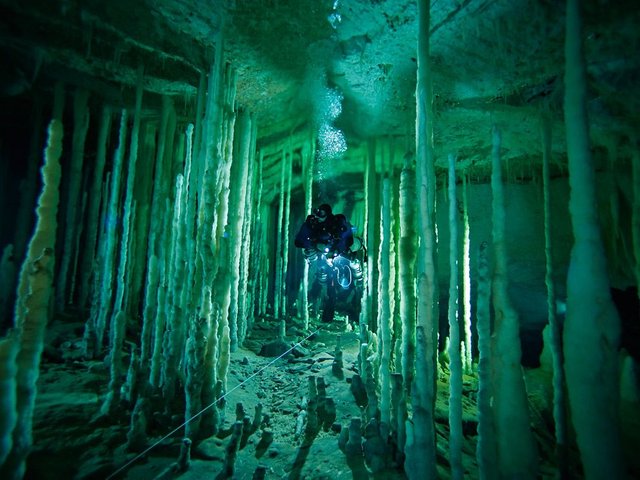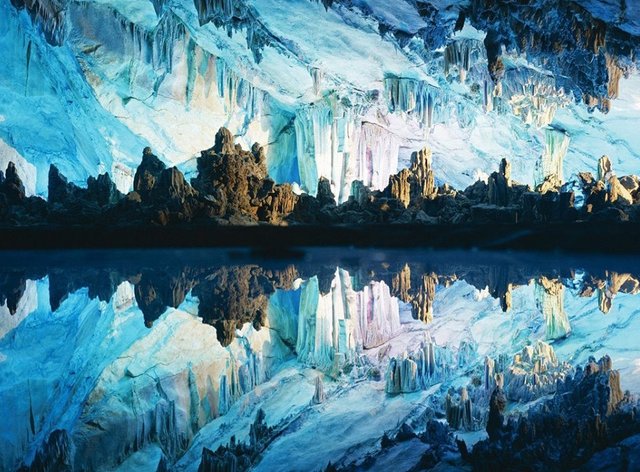Speleology
Karst
from Indo-European kar - stone
Karst is a geomorphologic phenomenon, a specific type of anhydrous and rocky relief, where water circulates in underground streams in soluble rocks (limestone and dolomite).
The complex operation of the water flow from the surface to the depths is crucial in forming this type of relief. Water enriched with CO2 dissolves limestone substrate, operating in both chemical (corrosion) or the mechanical (erosion) manner. After a certain period of time, the underground morphological karst relief develops - the pores and cracks in rocks, cavities and spaces different in sizes, shapes and depths - speleological objects caves, pits, abysses and icicles.
The largest underground karst area in Europe where sciences like karstology and speleology and biospeleology were born is the karst complex of Dinaric karst.

Image source: www.nationalgeographic.com
Blue hole cave in Bahamas
Ambience: Cave
French: grotte; German: Höhle
The cave usually has one main and several lateral mutually interwoven horizontal channels. The pit is a well-like crack of vertical or graded steepness.
In the process of the creation of underground cavities, cave jewelry as stalagmites, stalactites, cascades, draperies, helictites, pizolites and macaroni are formed by the activity of precipitated water enriched with carbon dioxide dissolving the limestone which crystallizes into calcite.
The physical environment of the cave is characterized by the absence of light, sound, relatively constant air temperature which is approximately equal to the annual average temperature of the cave surroundings, and the unusually high degree of humidity and low evaporation rates. Sucessfully adapted beings to life under specific conditions manifest some rudimentary characteristics as a reduction of pigment and eye, or stenothermy.
.jpg)
Ice cave. Image source: www.wallpaperup.com
Cave in Culture
The caves, spaces enclosed by silence and darkness, attracted and due to the fear of unknown rejected humankind.
According to Jung, who explored the symbolism and the subconscious, in the darkness of the underworld we are confronted with the demons of ourselves, the subconscious, and then it is possible to free oneself from the conditioning. Jung advocated cave journeys for the process of the psychotherapy - the journey to the interior of the cave from the psychological aspect is the journey within oneself which Jung describes as a "blissful and terrible experience".
And what thoughts and beliefs motivated the primordial man to go into the depths of the earth to do drawings, Vickers asks. Experts say that this is a part of a deep religious experience, that the depths of caves, inaccessible to life, served as sacred locations of shaman rituals in order to gain more life insight. Even to a contemporary rational explorer, these depths stimulate atavistic feelings – suddenly they are in the state of the irrational fear with 'disconnected' senses and they seem to see by their 'inner eye' – as they describe.
The cave as a space with spiritual dimension is found in both ancient and Christian culture. In Greek mythology god of gods - Zeus is born in the cave on Crete, and the oracle Sybil gets her inspiration. Also, they act as entrances to the underworld, the spaces between the worlds, places for the souls that are to be transformed into the afterlife.
In Christianity from the Middle Ages to modern times, the caves were the scene of visionary experiences such as the manifestation of Madonna in Lourdes, and the sometimes were homes of the Christian mystics.
In the cultures of the world, caves are associated with historical, fantastic and mythological stories. They are seen as places of power and creative energy, the residence of gods, demons, ghosts, ancestors, malicious forces and giants. Prior to the paleontological scientific discoveries, the bones in the caves were considered belonging to these mythical creatures dragons, and the proteus - the dragon’s baby. The monster in the cave is a widespread motif in the mythology of the world and the accompanying myth about the hero killing the dragon.

Image source: charismaticplanet.com
The Reed Flute Cave in China is over 180 million years old.
Literature:
Božičević, Srećko: Kroz naše špilje i jame, Mala znanstvena knjižnica Hrvatskoga prirodoslovnog društva, Zagreb, 1984.
Božičević, Srećko: Čovjek u podzemlju, Školska knjiga, Zagreb 1977.
Božić, Vlado: Speleologija u Hrvatskoj – speleološki priručnk, Hrvatski planinarski savez i HPD ''Željezničar'', Zagreb, 2003.
Romero, A.; Green, S.M.: The end of regressive evolution: examining and interpreting the evidence from cave fishes, Journal of Fish Biology (2005) 67, 3–32
Gottstein Matočec, Sanja; Ozimec, Roman; Jalžić, Branko; Kerovac, Mladen; Bakran-Petricioli, Tatjana: Raynolikost i ugroženost podzemne faune Hrvatske, Ministarstvo zaštite okoliša i prostornog uređenja Republike Hrvatske, Zagreb, 2002.
Natura Croatica, časopis hrvatskoga prirodoslovnog muzeja, vol.15, suppl.1, 1-154, Zagreb, October 2006, Bedek; Gottstein Matočec; Jalžić; Ozimec; Štamol: Katalog tipskih špiljskih lokaliteta faune hrvatske
Gunn, John: Encyclopedia of Caves and Karst Science, Taylor & Francis e-library, New York, 2006.
Barr, Jr., Thomas C.: Observation on the Ecology of Caves, The American Naturalist, Vol. 101, No. 922, November-December 1967.
White, William B., Culver, David C.: Encyclopedia of Caves; Elsevier, 2012.
Bilandžija, H., Bedek, J., Jalžić, B. & Gottstein, S.: The morphological variability, distribution patterns and endangerment in the Ogulin cave sponge Eunapius subterraneus Sket & Velikonja, 1984 (Demospongiae, Spongillidae). Nat. Croat., Vol. 16, No. 1., 1–17, 2007, Zagreb.
Vickers, Ilse: The Descent into the Cave; The Dynamic Relationship Between Paleolithic Cave Art and Depth Psychology, Bradshaw Foundation, London, 2013